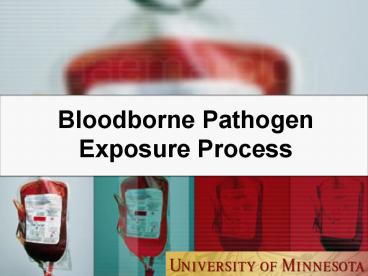Bloodborne Pathogen Exposure Process PowerPoint PPT Presentation
1 / 19
Title: Bloodborne Pathogen Exposure Process
1
Bloodborne Pathogen Exposure Process
2
What is a BB Pathogen?
- Microorganisms that are carried in the blood that
can cause disease in humans
3
Common BB Pathogen Diseases
- Hepatitis B(HBV)
- Hepatitis C(HCV)
- Human Immunodeficiency Virus (HIV)
4
Potentially Infectious Bodily Fluids
- Skin tissue, cell cultures
- Any other bodily fluid
- Blood
- Saliva
- Vomit
- Urine
- Semen or vaginal secretions
5
Transmission Potential
- Contact with another persons blood or bodily
fluid that may contain blood - Mucous membranes eyes, mouth, nose
- Non-intact skin
- Contaminated sharps/needles
6
Standard Precautions for Infection Control
- Handwashing - wash hands before and after patient
contact and after removing gloves - Gloves Wear when hands are likely to be exposed
to blood, body fluids, mucous membranes, or
contaminated articles. Change gloves between
tasks on the same patient. - Gown Wear a fluid resistant gown when clothing
is likely to be exposed to blood or body fluids
7
Standard Precautions for Infection Control (cont.)
- Mask, eye protection, face shield Wear to
protect eyes, nose and mouth during activities
that may result in splashing of blood or body
fluids - Sharps Do not recap needles or refer to
Infection Control for safe alternatives. Dispose
of sharps in appropriate containers.
8
University of MinnesotaBloodborne Pathogen
Exposure ProgramGME Standard Operating Procedures
9
Clean it.
- Immediately wash needlesticks and cuts with soap
and water - Flush splashes to the nose, mouth or skin with
water - Irrigate eyes with clean water, saline, or
sterile irrigants
10
Report it.
- Report the exposure to your supervising
preceptor, manager, or faculty.
11
Call For Help.
- 612-625-7900
- This is a 24 hour line for the University of
Minnesota Medical Information Nurse - The Triage Nurse will direct you to the
appropriate location for care - The CDC recommends that the exposed individual
seek treatment within 1-2 hrs after initial
exposure
12
Get treated.
- Go to the recommended facility for treatment ASAP
- Employee Health at your training facility, ED, or
BHS
13
ID Source Patient.
- Get the help of the preceptor and/or the
designated representative of the facility - They will assist you with obtaining consent and
having the source patients blood tested
14
Documentation
- Complete the Incident Report at your training
site OR use the University Employee Incident
Report Form available on the Workers Comp
website - Complete the First Report of Injury with your
supervisor within 24 hrs - Fax completed forms to the Occupational Health
Clinic at Boynton at 612-624-3310
15
Get follow-up.
- The OHN at BHS will contact the exposed person
within 3 business days to coordinate follow up
care - You will receive a written opinion with test
results and follow up information within 15 days
of the evaluation
16
(No Transcript)
17
Infected Healthcare Worker
- If a medical resident, fellow or student is
infected with HCV, HBV, or HIV, he/she must
report this infection to the Medical Schools
Blood Borne Infectious Disease Review Panel by
contacting the University of Minnesota Office of
Occupational Health and Safety at uohs_at_umn.edu or
612-626-5008. This reporting is required by
Minnesota law.
18
In Conclusion
- BB pathogen rules are in place for your health
and safety - Failure to follow them is a risk that does not
need to be taken
19
Questions?

